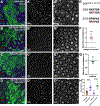Mushroom bodies tiny regulates Sidekick localization to tricellular adherens junctions
- PMID: 40888741
- PMCID: PMC12625736
- DOI: 10.1242/dev.204777
Mushroom bodies tiny regulates Sidekick localization to tricellular adherens junctions
Abstract
The Drosophila cell-adhesion molecule Sidekick is a key component of tricellular adherens junctions in epithelia and localizes to specific synaptic layers in the optic lobes. Using mutagenesis of endogenous Sidekick, we showed that its enrichment at apical tricellular junctions and its function in cell rearrangement require its fifth and sixth immunoglobulin domains, but not the first four, although these mediate homophilic adhesion of mammalian Sidekick homologues. The C-terminal PDZ-binding motif of Sidekick contributes to localizing both Sidekick and its intracellular binding partner Canoe to tricellular adherens junctions. We found that the PAK4 homologue Mushroom bodies tiny also binds to the cytoplasmic domain of Sidekick. Its kinase activity is necessary for Sidekick accumulation at tricellular junctions, and over-activity mislocalizes Sidekick along bicellular junctions. However, mutating predicted Mushroom bodies tiny phosphorylation sites in Sidekick itself did not affect its localization. Sidekick localizes to the dendrites of T4 and T5 neurons independently of its extracellular and PDZ-binding domains, and of Mushroom bodies tiny. Our findings reveal an important role for a PAK4 family member in establishing specialized structures at tricellular adherens junctions.
Keywords: Junction; PAK4; Sdk; Synapse; Tricellular.
© 2025. Published by The Company of Biologists.
Conflict of interest statement
Competing interests The authors declare no competing or financial interests.
Figures







References
-
- Byri S, Misra T, Syed ZA, Batz T, Shah J, Boril L, Glashauser J, Aegerter-Wilmsen T, Matzat T, Moussian B, et al. (2015). The triple-repeat protein Anakonda controls epithelial tricellular junction formation in Drosophila. Dev Cell 33, 535–548. - PubMed
MeSH terms
Substances
Grants and funding
LinkOut - more resources
Full Text Sources
Research Materials

